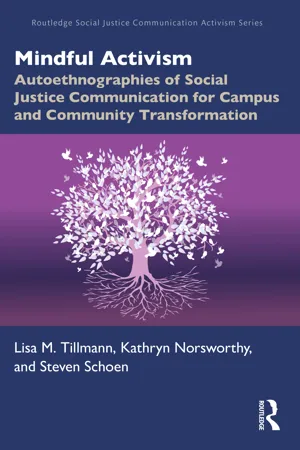
Mindful Activism
Autoethnographies of Social Justice Communication for Campus and Community Transformation
Lisa M. Tillmann, Kathryn Norsworthy, Steven Schoen
- 181 páginas
- English
- ePUB (apto para móviles)
- Disponible en iOS y Android
Mindful Activism
Autoethnographies of Social Justice Communication for Campus and Community Transformation
Lisa M. Tillmann, Kathryn Norsworthy, Steven Schoen
Información del libro
This collection immerses scholars of communication and related disciplines in narratives of and conversations about social-justice-focused activism.
Through autoethnographic essays, Mindful Activism chronicles the authors' experiences as activist academics challenging and seeking to remedy injustices on campus and in local and global communities. Those experiences range from engaging in a single activist act to collaborating over many years with oppressed communities and social change groups. Building upon communication activism research and following a liberation-based transformative learning model, the book shows both activism in action and deep reflection on that activism. The authors re-experience activist experiences, draw out lessons, and invite readers to apply those to their own social justice endeavors. Mindful Activism also demonstrates how mindfulness supports activists in deepening their awareness and understanding of themselves, others, and social systems. This orientation increases the likelihood that activists will remain grounded enough to respond to injustice mindfully/effectively.
The book will enrich courses on activism, social justice, dialogue, narrative inquiry, qualitative methods, autoethnography, and general graduate studies, and will resonate with scholars committed to building a more equitable and just world.
Preguntas frecuentes
Información
1 SITTING OUT "THE STAR-SPANGLED BANNER"1
Coauthors Arrive at the Chapter Debrief2
(Auto)ethnographic4 Narrative
Índice
- Cover
- Half Title
- Series
- Title
- Copyright
- Dedication
- Contents
- List of Contributors
- Preface
- Acknowledgements
- Introduction: Birthing the Book
- 1 Sitting Out "The Star-Spangled Banner"
- 2 Of All Days: Critical Pedagogy Outside the Classroom
- 3 Queer Border Crossings
- 4 Wind and Winding Roads: Friendship amid Indefinite Confinement
- 5 "Say It Ain't So": Protecting a Nondiscrimination Policy from Appropriated Diversity
- Conclusion: Mindful Activists Debrief Mindful Activism
- Index